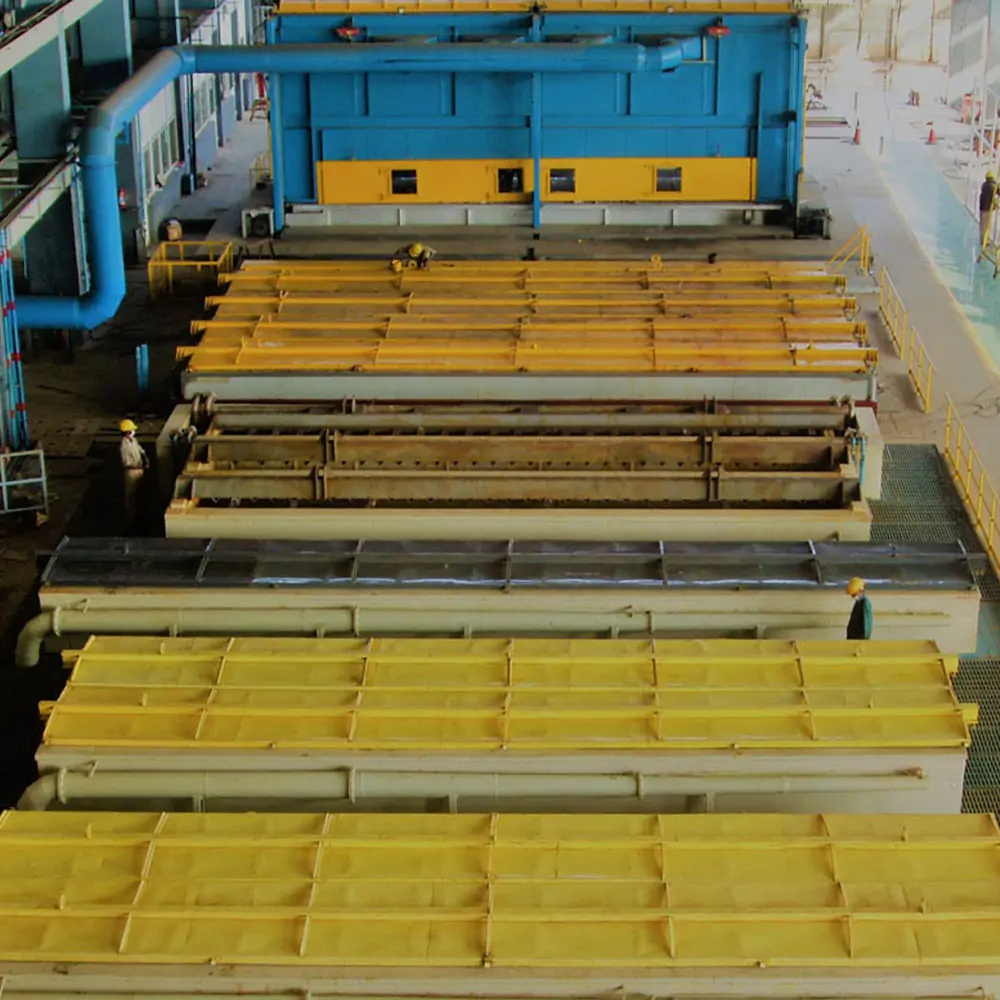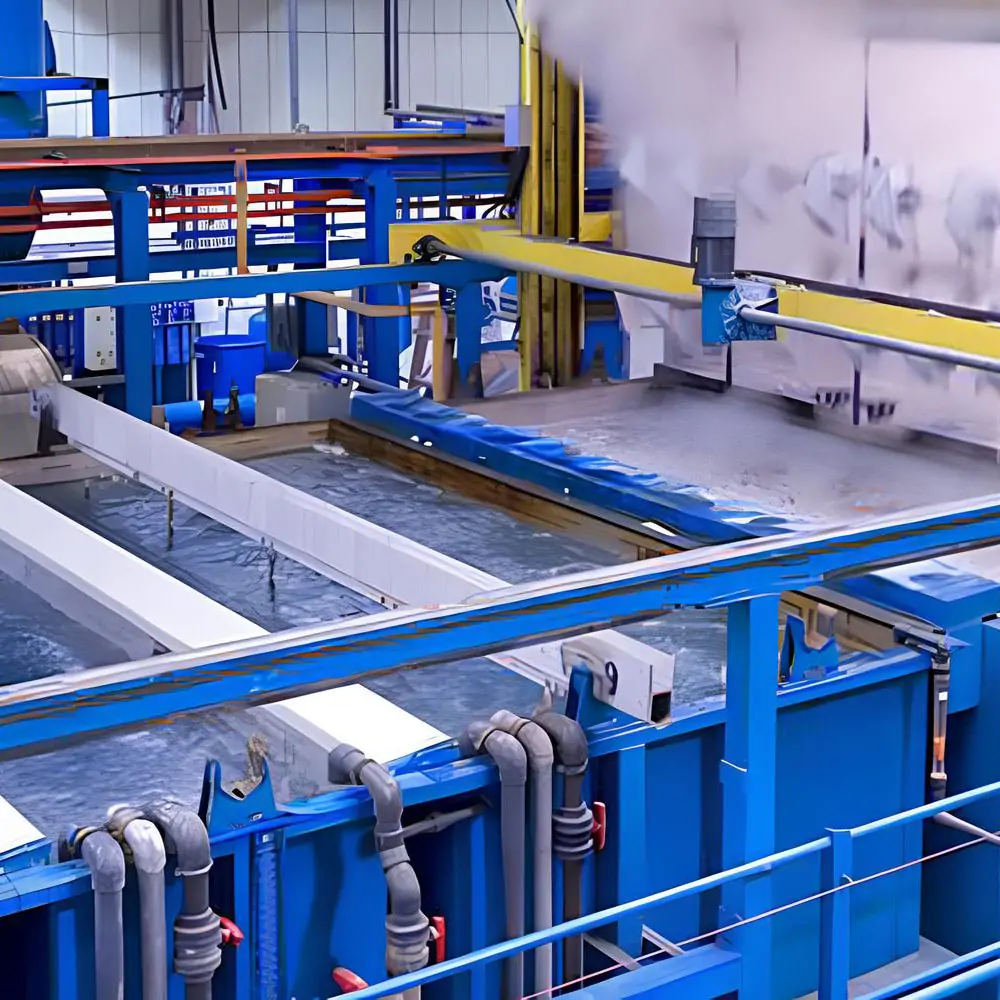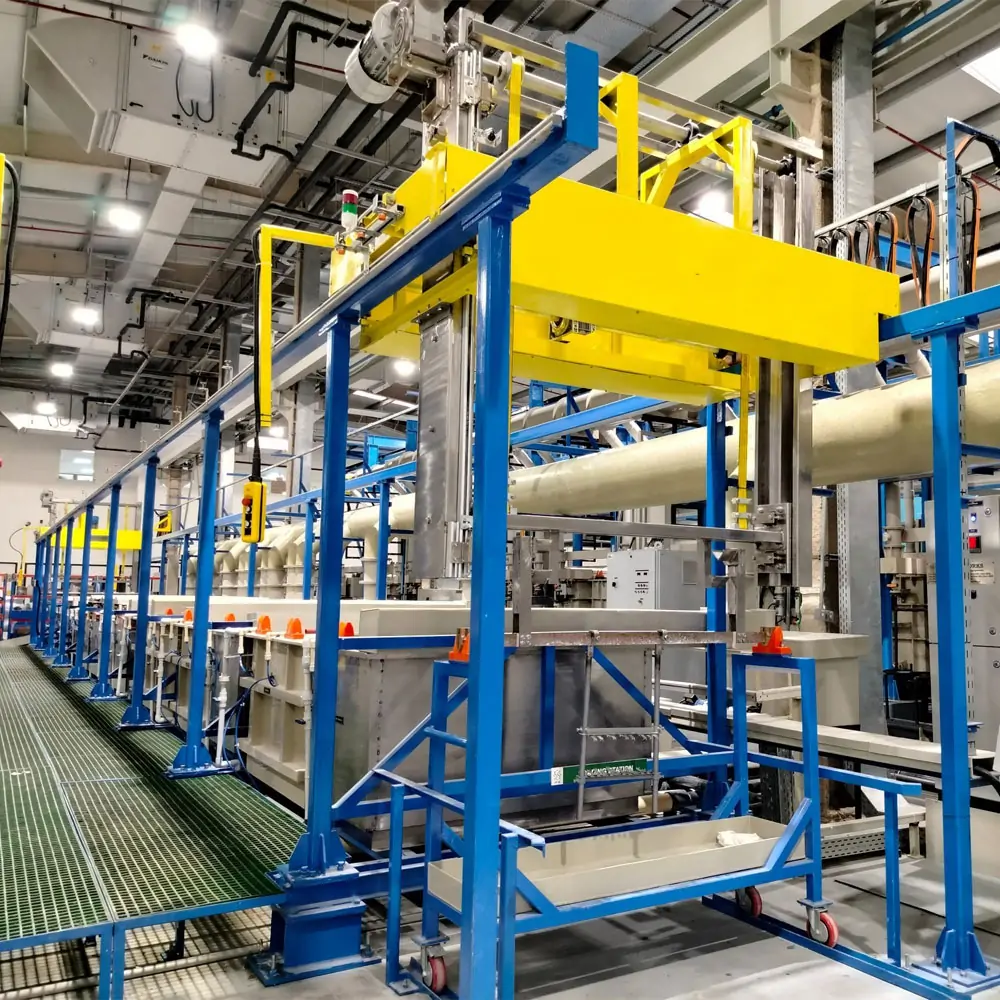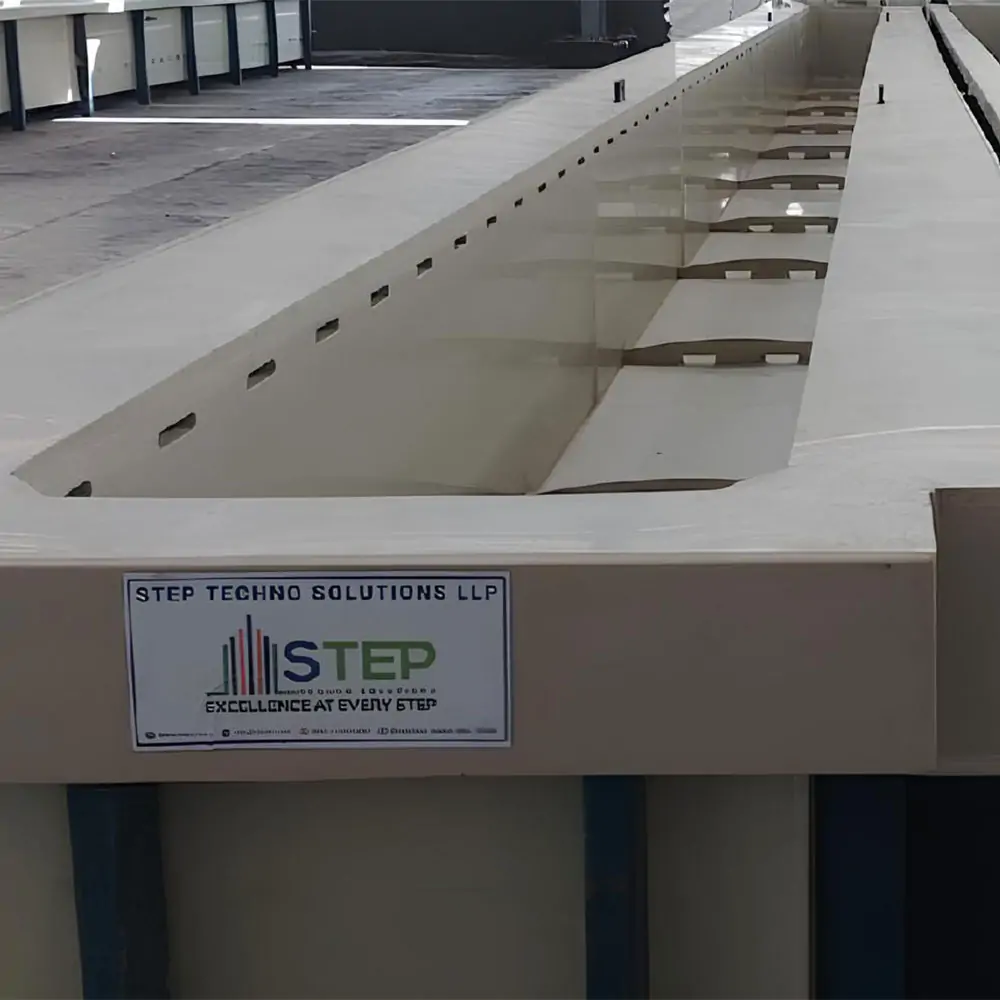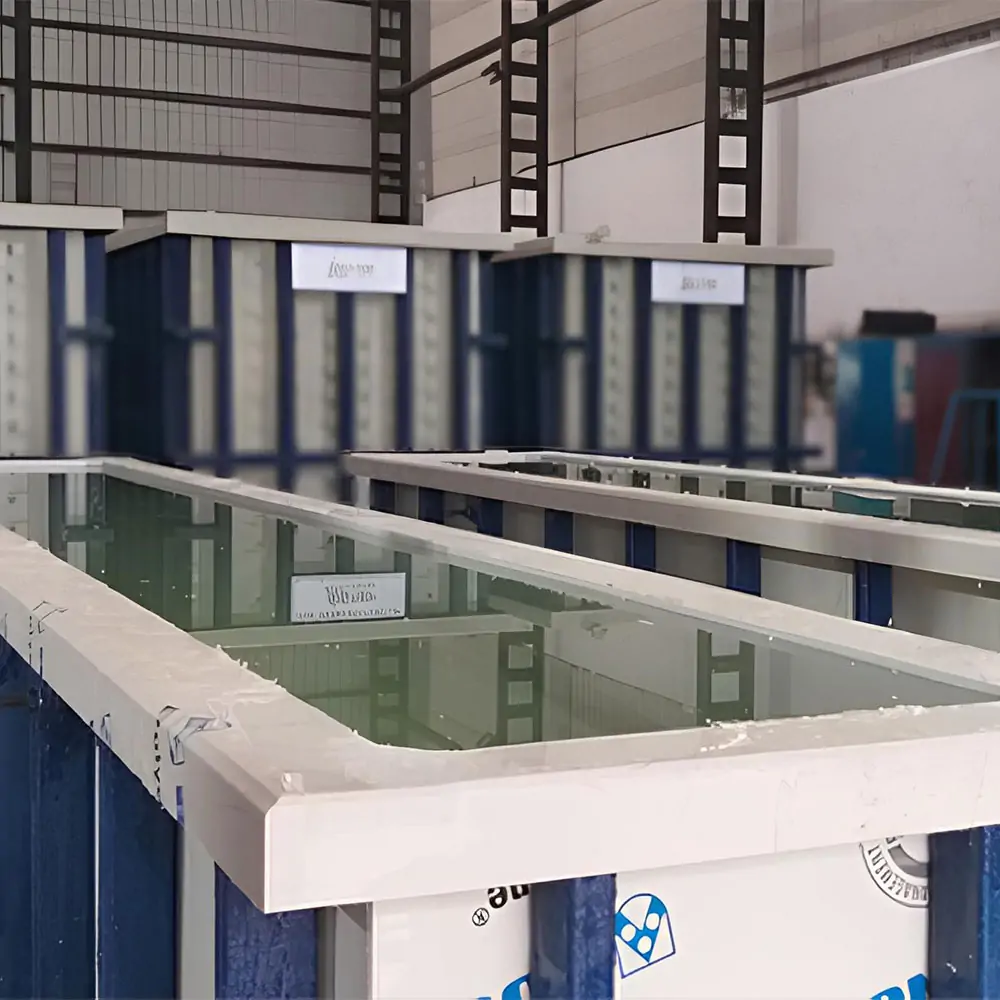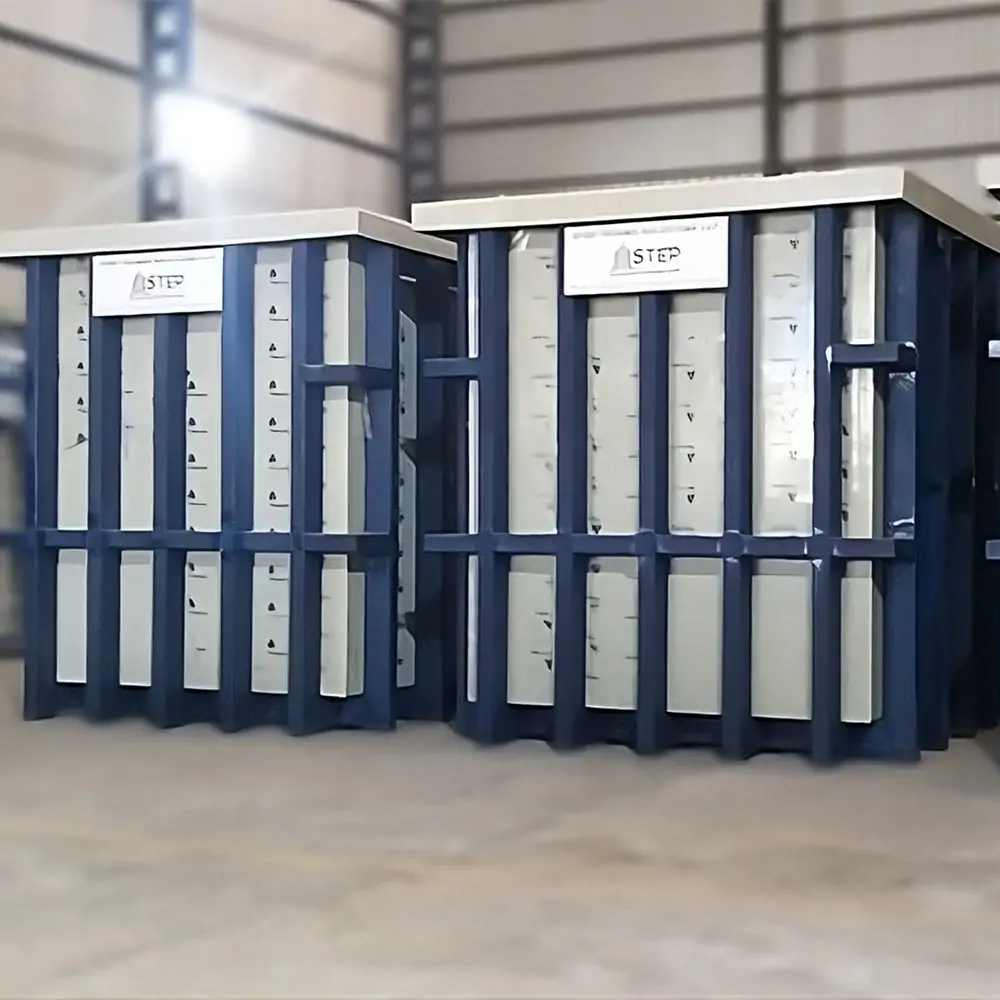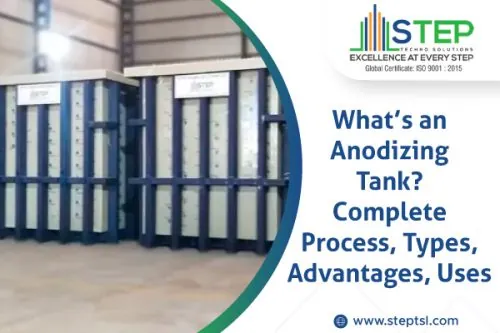What is an Anodizing Tank?
An anodizing tank is a specialized container used in the electrochemical process of anodizing, which transforms the surface of metals like aluminum into a durable, decorative, and corrosion-resistant oxide finish. The process involves immersing the metal in an acid electrolyte bath within the anodizing tank and applying an electric current, causing oxygen ions to bond with the metal’s surface and create a robust oxide layer. Different types of anodizing tanks, such as pre-treatment, dyeing, and sealing tanks, cater to various stages of the process. The advantages of using anodizing tanks include enhanced corrosion resistance, improved wear durability, and the ability to achieve vibrant colors. These tanks are widely used in industries like aerospace, automotive, and electronics for superior metal surface treatment
An anodizing tank is a strong, chemically resistant container used to store electrolytic solutions and aid in the anodizing process. Its main purpose is to provide a stable environment for the electrochemical reaction that forms a protective oxide layer on the metal surface, typically aluminum, magnesium, or titanium. Anodizing tanks are specialized containers used in the anodizing process, an electrochemical method that enhances the surface properties of metals, especially aluminum. These tanks provide a regulated environment for metals to convert, resulting in a protective oxide coating that improves their durability, look, and corrosion resistance.
The importance of anodizing tanks in metal surface treatment cannot be overstated. They ensure uniformity, quality, and efficiency in the anodizing process, making them essential for industries that demand high-performance metal finishes. In India, the demand for high-quality anodizing tanks has led to the emergence of several leading manufacturers, recognized for their advanced engineering and commitment to excellence.
Components of an Anodizing Tank
A standard anodizing tank setup includes:
- Tank Body: Made from materials like polypropylene (PP), polyvinyl chloride (PVC), stainless steel, or alloy steel, often lined with corrosion-resistant plastics
- Cathodes and Anodes: Metal parts to be anodized act as the anode, while cathodes (often lead or stainless steel) complete the circuit.
- Electrolyte Solution: Usually sulfuric acid or other suitable acids, depending on the anodizing type.
- Heating and Cooling Systems: To maintain optimal temperature during anodizing.
- Agitation System: Ensures even distribution of electrolyte and uniform anodizing.
- Power Supply: Provides the necessary current for the electrochemical reaction.
Different Types of Anodizing Tanks
- Pre-treatment Tanks: The pre-treatment tanks areused for cleaning and preparing metal surfaces before anodizing.
- Main Anodizing Tanks: Where the actual anodizing occurs, forming the oxide layer.
- Dyeing Tanks: For adding color to anodized surfaces.
- Sealing Tanks: Seal the pores of the anodized layer, enhancing corrosion resistance
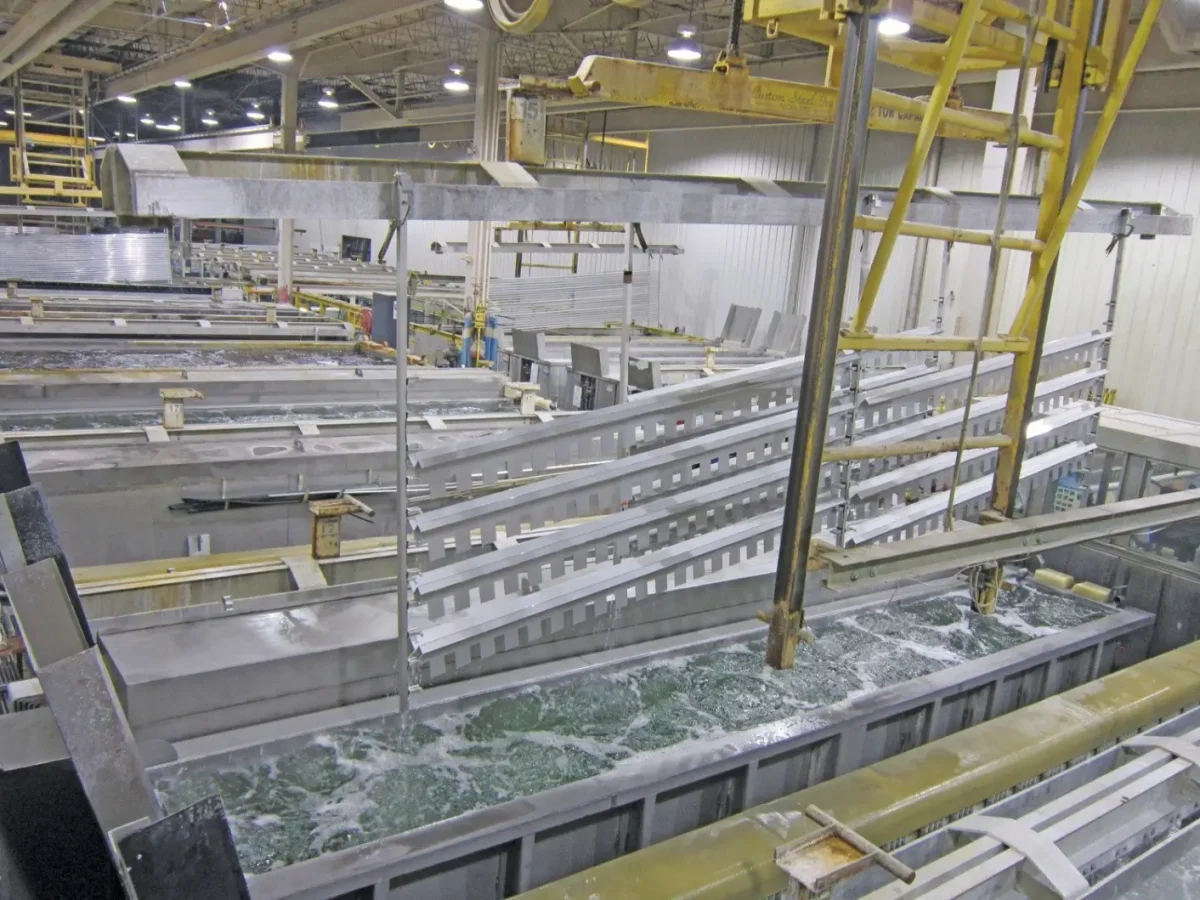
The Anodizing Process
Step-by-Step Explanation of the Anodizing Process
- Cleaning and Pre-treatment: Metal parts are cleaned in pre-treatment tanks to remove contaminants.
- Anodizing: The cleaned parts are submerged in the anodizing tank filled with electrolyte. An electric current passes through, causing the metal surface to oxidize and form a protective layer.
- Dyeing (Optional): If color is desired, parts are immersed in a dyeing tank.
- Sealing: The anodized parts are placed in a sealing tank to close the pores of the oxide layer, locking in color and enhancing protection
Importance in Metal Finishing
Anodizing is vital for metal finishing because it:
- Increases corrosion and wear resistance
- Improves surface hardness
- Allows for vibrant, long-lasting colors
- Enhances adhesion for paints and adhesives
Benefits of Using an Anodizing Tank
- Consistent Quality: Uniform oxide layers for reliable performance.
- Process Control: Precise temperature, current, and chemical management.
- Efficiency: Batch processing for large volumes of parts.
Types of Anodizing Tanks
- Polypropylene (PP) Tanks: Lightweight, chemical-resistant, and cost-effective.
- PVC-Lined Tanks: Offer excellent corrosion resistance, suitable for aggressive electrolytes.
- Stainless Steel Tanks: Durable and ideal for high-temperature operations.
- Custom-Made Tanks: Designed for specific industrial requirements, including size, shape, and automation features
Comparison of Tank Materials and Designs
| Material | Durability | Chemical Resistance | Cost | Applications |
| Polypropylene | High | Excellent | Moderate | General anodizing |
| PVC | Good | Excellent | Moderate | Aggressive environments |
| Stainless Steel | Very High | Good | High | High-temp, heavy-duty |
| Alloy Steel | High | Good | High | Specialized processes |
Factors to Consider When Choosing an Anodizing Tank
- Type of metal to be anodized
- Size and volume of parts
- Chemical compatibility
- Temperature requirements
- Automation and process control needs
- Maintenance and serviceability
Advantages of Anodizing Tanks
- Durability and Long-Lasting Finish: Anodizing tanks enable the creation of hard, wear-resistant oxide layers that extend the lifespan of metal components, even in harsh environments
- Improved Corrosion Resistance: The anodized covering protects the parts from rust, salt, and chemicals, making them suited for outdoor and marine applications.
- Customization Options: Anodizing tanks allow for a wide range of colors, finishes, and thicknesses, catering to diverse aesthetic and functional requirements
Additional Benefits
- Enhanced UV stability—resistant to fading and discoloration
- Improved electrical insulation for electronic components
- Eco-friendly and non-toxic process
- Reduced maintenance and repair costs
Uses of Anodizing Tanks
Industries that Utilize Anodizing Tanks
- Aerospace: For structural components, landing gear, and casings requiring lightweight strength and corrosion resistance
- Automotive: Used for wheels, trim, and chassis parts to improve durability and appearance
- Electronics:The housings, heat sinks, and shields are coated for insulation and Electromagnetic protection.
- Architecture: Treating window frames, curtain walls, and façade elements for weather resistance
- Military and Defense: Enhancing durability and mechanical properties of equipment
Applications in Key Industries
| Industry | Application Examples | Benefits |
| Aerospace | Structural parts, landing gear | Lightweight, corrosion-resistant |
| Automotive | Wheels, trims, chassis | Durable, aesthetic, safe |
| Electronics | Enclosures, heat sinks | Insulation, EMI protection |
| Architecture | Window frames, facades | Weatherproof, long-lasting |
| Military | Equipment components | Rugged, reliable |
Benefits of Metal Surface Treatments
Metal surface treatments offer numerous benefits that enhance the performance and longevity of metal components. Processes like anodizing improve corrosion resistance, making metals more durable in harsh environments. They also increase surface hardness, reducing wear and tear, and provide better adhesion for paints and coatings. Additionally, surface treatments can enhance the aesthetic appeal of metals by enabling vibrant colors and smooth finishes. These improvements are essential for industries such as aerospace, automotive, and electronics, where reliability and appearance matter. Overall, metal surface treatments ensure components are stronger, longer-lasting, and visually appealing, meeting the rigorous standards of modern manufacturing.
Choosing the Best Anodizing Tank in India
Factors to Consider
- Tank Material: Choose based on chemical resistance and temperature needs.
- Capacity: Match tank size to production volume.
- Automation Level: Consider manual vs. automated systems for efficiency.
- Customization: Look for manufacturers offering tailored solutions.
- After-Sales Support: Reliable maintenance and service are crucial for long-term performance
Tips for Maintaining and Servicing an Anodizing Tank
- Regularly inspect for leaks, corrosion, and wear
- Clean tanks and replace electrolytes as needed
- Monitor temperature and chemical concentrations
- Schedule periodic maintenance with the manufacturer
Who is the Leading Anodizing Tanks Manufacturer in India?
India’s anodizing tank industry is recognized for its advanced technology, quality manufacturing, and commitment to innovation, making it a global hub for metal surface treatment solutions. Leading anodizing tank manufacturers in India supply a comprehensive range of products, from standard anodizing tanks to fully customized process anodizing tanks, ensuring durability, efficiency, and precision for a wide array of industrial applications. These manufacturers are known for their expertise in engineering tanks that meet stringent industry standards, providing reliable performance and long service life for sectors such as aerospace, automotive, electronics, and architecture. Whether you need an anodizing tank for metal surface treatment or a specialized tank for a unique process, Indian manufacturers deliver world-class solutions backed by robust after-sales support and technical guidance. Among them, STEP® Techno Solutions LLP stands out as a prominent anodizing tank manufacturer in India, offering high-quality tanks and plating systems tailored to specific client requirements. Their reputation as a leading manufacturer of anodizing and plating tanks, as well as a process anodizing tank manufacturer, is built on a foundation of innovation, customer focus, and proven results. For businesses seeking reliable anodizing tank solutions in India, STEP® Techno Solutions LLP is the trusted choice for quality and performance. Their expertise and commitment make them a trusted choice for businesses seeking reliable anodizing tank solutions in India.
Why Choose STEP® Techno Solutions LLP?
When it comes to selecting an anodizing tank manufacturer in India, STEP® Techno Solutions LLP stands out for its industry experience, state-of-the-art infrastructure, and dedication to customer satisfaction. With over 25+ years of expertise, STEP® Techno Solutions LLP designs and manufactures high-quality anodizing tanks and surface treatment plants designed to client requirements. Their products are widely used across India, the Middle East, Africa, and the Far East, making them a trusted partner for businesses seeking reliable solutions for metal surface treatment
Conclusion
Anodizing tanks are essential for achieving high-performance, corrosion-resistant, and aesthetically pleasing metal finishes. Their role in industries like aerospace, automotive, electronics, and construction underscores their value in modern manufacturing. Investing in a high-quality anodizing tank ensures consistent results, long-lasting durability, and the flexibility to meet diverse application needs.
Ready to elevate your metal surface treatment process? Discover the benefits of advanced anodizing tanks with the leading manufacturer of anodizing and plating tanks in India. For more information, expert guidance, or to request a quote, contact STEP® Techno Solutions LLP at +91 98988 75757 or email info@steptsl.com. Unlock the full potential of your production with the best anodizing tank for metal surface treatment.
FAQs of Anodizing Tanks
1. What metals can be anodized in an anodizing tank?
Aluminum is most commonly anodized, but titanium and magnesium can also undergo anodizing in an anodizing tank for improved corrosion resistance and surface properties.
2. How does the anodizing process work in a tank?
The metal portion has been immersed in an electrolyte solution, and an electric current is sent by, resulting in the building of a long-lasting anodic oxide layer on the metal surface.
3. What are the main types of anodizing tanks?
There are pre-treatment, anodizing, dyeing, sealing, and post-treatment tanks, each serving a specific function in the anodizing process.
4. Why is sealing important after anodizing in a tank?
Sealing closes the pores of the anodized layer, enhancing corrosion resistance and preventing dirt or contaminants from penetrating the metal surface.
5. What materials are anodizing tanks made from?
Anodizing tanks are often made from alloy steel, stainless steel, or lined with plastics like PVC to resist corrosion from acidic electrolytes.
6. How is color added during anodizing in a tank?
After anodizing, the porous surface can be dyed in a dyeing tank, allowing various colors to be absorbed before the final sealing step.
7. What are the benefits of using anodizing tanks?
Anodizing tanks provide enhanced corrosion resistance, increased surface hardness, improved aesthetics, and allow for coloring and better adhesion of paints or adhesives.
8. How is maintenance performed on anodizing tanks?
Regular cleaning with deionized water, inspection for corrosion, and ensuring proper rinsing and drying help extend the tank’s lifespan and maintain performance.
9. Why is anodizing preferred over painting or plating?
The anodic oxide layer formed in an anodizing tank is integral to the metal, so it won’t chip or peel like paint or plating, ensuring long-lasting protection and finish

